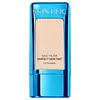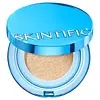What's inside
What's inside
 Key Ingredients
Key Ingredients

 Benefits
Benefits

 Concerns
Concerns

 Ingredients Side-by-side
Ingredients Side-by-side

Water
Skin ConditioningCyclopentasiloxane
EmollientCI 77891
Cosmetic ColorantPropylene Glycol
HumectantTrimethylsiloxysilicate
EmollientDimethicone
EmollientPropylene Glycol Dicaprylate/Dicaprate
EmollientIsononyl Isononanoate
EmollientPolymethylsilsesquioxane
Butylene Glycol
HumectantCI 77492
Cosmetic ColorantGlycerin
HumectantLauryl PEG-10 Tris(Trimethylsiloxy)Silylethyl Dimethicone
EmulsifyingSqualane
EmollientVinyl Dimethicone/Methicone Silsesquioxane Crosspolymer
Tridecyl Trimellitate
EmollientMagnesium Sulfate
Silica
AbrasivePhenoxyethanol
PreservativeSorbitan Sesquiisostearate
EmulsifyingCI 77491
Cosmetic ColorantDimethicone/Vinyl Dimethicone Crosspolymer
Skin ConditioningPolysilicone-11
Triethoxycaprylylsilane
Aluminum Hydroxide
EmollientQuaternium-18 Bentonite
Betaine
HumectantPanthenol
Skin ConditioningCI 77499
Cosmetic ColorantEthylhexylglycerin
Skin ConditioningMethicone
EmollientPentaerythrityl Tetra-Di-T-Butyl Hydroxyhydrocinnamate
AntioxidantSynthetic Fluorphlogopite
Tocopherol
AntioxidantWater, Cyclopentasiloxane, CI 77891, Propylene Glycol, Trimethylsiloxysilicate, Dimethicone, Propylene Glycol Dicaprylate/Dicaprate, Isononyl Isononanoate, Polymethylsilsesquioxane, Butylene Glycol, CI 77492, Glycerin, Lauryl PEG-10 Tris(Trimethylsiloxy)Silylethyl Dimethicone, Squalane, Vinyl Dimethicone/Methicone Silsesquioxane Crosspolymer, Tridecyl Trimellitate, Magnesium Sulfate, Silica, Phenoxyethanol, Sorbitan Sesquiisostearate, CI 77491, Dimethicone/Vinyl Dimethicone Crosspolymer, Polysilicone-11, Triethoxycaprylylsilane, Aluminum Hydroxide, Quaternium-18 Bentonite, Betaine, Panthenol, CI 77499, Ethylhexylglycerin, Methicone, Pentaerythrityl Tetra-Di-T-Butyl Hydroxyhydrocinnamate, Synthetic Fluorphlogopite, Tocopherol
Water
Skin ConditioningCyclopentasiloxane
EmollientCI 77891
Cosmetic ColorantTrimethylsiloxysilicate
EmollientButylene Glycol
HumectantCyclohexasiloxane
EmollientPolyglyceryl-3 Diisostearate
EmulsifyingSynthetic Fluorphlogopite
PEG-10 Dimethicone
Skin ConditioningIsododecane
EmollientNiacinamide
SmoothingCopper Tripeptide-1
Skin ConditioningDisteardimonium Hectorite
StabilisingAstaxanthin
Skin ConditioningTocopherol
AntioxidantPEG/PPG-18/18 Dimethicone
EmulsifyingTriethoxycaprylylsilane
CI 77492
Cosmetic ColorantPolymethylsilsesquioxane
Ergothioneine
AntioxidantBetaine
HumectantPropylene Carbonate
SolventCaprylyl Glycol
EmollientCI 77491
Cosmetic ColorantGlutathione
CI 77499
Cosmetic ColorantEthylhexylglycerin
Skin ConditioningMagnesium Sulfate
Phenoxyethanol
PreservativeTribehenin
EmollientAluminum Hydroxide
EmollientTricholoma Matsutake Extract
Skin ConditioningPentylene Glycol
Skin ConditioningWater, Cyclopentasiloxane, CI 77891, Trimethylsiloxysilicate, Butylene Glycol, Cyclohexasiloxane, Polyglyceryl-3 Diisostearate, Synthetic Fluorphlogopite, PEG-10 Dimethicone, Isododecane, Niacinamide, Copper Tripeptide-1, Disteardimonium Hectorite, Astaxanthin, Tocopherol, PEG/PPG-18/18 Dimethicone, Triethoxycaprylylsilane, CI 77492, Polymethylsilsesquioxane, Ergothioneine, Betaine, Propylene Carbonate, Caprylyl Glycol, CI 77491, Glutathione, CI 77499, Ethylhexylglycerin, Magnesium Sulfate, Phenoxyethanol, Tribehenin, Aluminum Hydroxide, Tricholoma Matsutake Extract, Pentylene Glycol
Ingredients Explained
These ingredients are found in both products.
Ingredients higher up in an ingredient list are typically present in a larger amount.
Aluminum Hydroxide is a form of aluminum. It can be naturally found in nature as the mineral gibbsite. In cosmetics, Aluminum Hydroxide is used as a colorant, pH adjuster, and absorbent.
As a colorant, Aluminum Hydroxide may add opacity, or reduce the transparency. Aluminum hydroxide is contains both basic and acidic properties.
According to manufacturers, this ingredient is an emollient and humectant. This means it helps hydrate the skin.
In medicine, this ingredient is used to help relieve heartburn and help heal ulcers.
There is currently no credible scientific evidence linking aluminum hydroxide in cosmetics to increased cancer risk.
Major health organizations allow the use of aluminum hydroxide in personal care products and have not flagged it as a carcinogenic risk at typical usage levels.
Learn more about Aluminum HydroxideBetaine is a common humectant (a substance that promotes retention of moisture). It's known to be gentle on the skin and can help balance hydration.
This ingredient is best for improving hydration and soothing irritated skin. Studies also show it helps even out skin tone.
Fun fact: Betaine is naturally created in the skin and body. The kind found within cosmetic products can be either plant-derived or synthetic.
Another name for betaine is trimethylglycine.
Learn more about BetaineButylene Glycol (or BG) is used within cosmetic products for a few different reasons:
Overall, Butylene Glycol is a safe and well-rounded ingredient that works well with other ingredients.
Though this ingredient works well with most skin types, some people with sensitive skin may experience a reaction such as allergic rashes, closed comedones, or itchiness.
Learn more about Butylene GlycolCi 77491 is also hydrated iron III oxide. It's sole purpose is to give a red/pink hue to products.
Iron III oxides are classified as inorganic chemicals for coloring.
Synthetically created Ci 77491 is considered safer than those naturally found. This is because the synthetically created version may contain less impurities. Iron oxides are generally non-toxic and non-allergenic.
Learn more about CI 77491Ci 77492 is also hydrated iron III oxide. It's sole purpose is to give a yellow hue to products.
Iron III oxides are classified as inorganic chemicals for coloring.
Synthetically created Ci 77492 is considered safer than those naturally found. This is because the synthetically created version may contain less impurities. Iron oxides are generally non-toxic and non-allergenic.
Learn more about CI 77492Ci 77499 is also hydrated iron III oxide. It is created from mixing red and black iron oxides. This helps give shades of darkness to a product.
Iron III oxides are classified as inorganic chemicals for coloring.
Ci 77891 is a white pigment from Titanium dioxide. It is naturally found in minerals such as rutile and ilmenite.
It's main function is to add a white color to cosmetics. It can also be mixed with other colors to create different shades.
Ci 77891 is commonly found in sunscreens due to its ability to block UV rays.
Learn more about CI 77891Cyclopentasiloxane, or D5, is a silicone used to improve texture of products and trap moisture.
D5 is considered lightweight and volatile. Volatile means it evaporates quickly after application. Once evaporated, D5 leaves a thin barrier that helps keep skin hydrated.
It is also an emollient. Emollients help soften the skin and prevent water loss. Silicones create a silky texture in products. D5 helps other ingredients become more spreadable.
Studies show D5 is safe to use in skincare products. We recommend speaking with a skincare professional if you have concerns.
Learn more about CyclopentasiloxaneEthylhexylglycerin (we can't pronounce this either) is commonly used as a preservative and skin softener. It is derived from glyceryl.
You might see Ethylhexylglycerin often paired with other preservatives such as phenoxyethanol. Ethylhexylglycerin has been found to increase the effectiveness of these other preservatives.
Magnesium Sulfate is a salt. More specifically, it is an epsom salt, or the bath salt used to help relieve muscle aches.
Despite having ‘sulfate’ in the name, it isn’t a surfactant or cleansing agent like sodium lauryl sulfate. Unlike those sulfates, magnesium sulfate doesn’t have the same cleansing or foaming properties (it's simply a type of salt).
In cosmetics, Magnesium Sulfate is used to thicken a product or help dilute other solids. It is a non-reactive and non-irritating ingredient.
One study shows magnesium deficiency may lead to inflammation of the skin. Applying magnesium topically may help reduce inflammation.
You can find this ingredient in sea water or mineral deposits.
Learn more about Magnesium SulfatePhenoxyethanol is a preservative that has germicide, antimicrobial, and aromatic properties. Studies show that phenoxyethanol can prevent microbial growth. By itself, it has a scent that is similar to that of a rose.
It's often used in formulations along with Caprylyl Glycol to preserve the shelf life of products.
Polymethylsilsesquioxane is a silicone used as a film forming agent.
When applied to the skin, this ingredient creates an invisible film on the surface. This film still allows oxygen to pass through, but prevents moisture from escaping. This can help condition and hydrate the skin. It also leaves a silky feel when applied.
Polymethylsilsesquioxane has not been shown to clog pores. It has been deemed safe to use up to 55%, but most cosmetics use much less.
If you have concerns about using this ingredient, we recommend speaking with a professional.
Learn more about PolymethylsilsesquioxaneSynthetic Fluorphlogopite is the synthethic version of mica. It consists of fluorine, aluminum and silicate.
Synthetic Fluorphlogopite is used to add volume to products.
It is considered non-irritating on the skin.
Learn more about Synthetic FluorphlogopiteTocopherol (also known as Vitamin E) is a common antioxidant used to help protect the skin from free-radicals and strengthen the skin barrier. It's also fat soluble - this means our skin is great at absorbing it.
Vitamin E also helps keep your natural skin lipids healthy. Your lipid skin barrier naturally consists of lipids, ceramides, and fatty acids. Vitamin E offers extra protection for your skin’s lipid barrier, keeping your skin healthy and nourished.
Another benefit is a bit of UV protection. Vitamin E helps reduce the damage caused by UVB rays. (It should not replace your sunscreen). Combining it with Vitamin C can decrease sunburned cells and hyperpigmentation after UV exposure.
You might have noticed Vitamin E + C often paired together. This is because it is great at stabilizing Vitamin C. Using the two together helps increase the effectiveness of both ingredients.
There are often claims that Vitamin E can reduce/prevent scarring, but these claims haven't been confirmed by scientific research.
Learn more about TocopherolTriethoxycaprylylsilane is a silicone used to bind and stabilize ingredients.
As an emulsifier, it helps prevent ingredients from separating. This can help elongate the shelf life of products.
Triethoxycaprylylsilane is often used to coat mineral sunscreens ingredients to help give a better feel. It also helps reduce oxidative stress in sunscreens.
Learn more about TriethoxycaprylylsilaneThis silicone is an emollient. Emollients create a thin film on the skin to prevent moisture from escaping.
It is not soluble in water and helps increase water-resistance in products.
According to a manufacturer, it can blend seamlessly with silicone oils, such as Cyclopentasiloxane.
Learn more about TrimethylsiloxysilicateWater. It's the most common cosmetic ingredient of all. You'll usually see it at the top of ingredient lists, meaning that it makes up the largest part of the product.
So why is it so popular? Water most often acts as a solvent - this means that it helps dissolve other ingredients into the formulation.
You'll also recognize water as that liquid we all need to stay alive. If you see this, drink a glass of water. Stay hydrated!
Learn more about Water